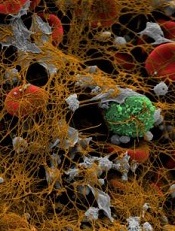
Credit: Andre E.X. Brown
New research suggests patients with hereditary hemorrhagic telangiectasia (HHT) have an increased risk of ischemic stroke if they are iron deficient, and this may be due to enhanced platelet aggregation.
In the last few years, several studies have shown that iron deficiency may be a risk factor for ischemic stroke, but exactly how this occurs has been unclear.
Previous research also revealed a possible link between iron deficiency and platelet aggregation, but it has been largely overlooked, until now.
Claire Shovlin, PhD, of Imperial College London in the UK, and her colleagues found that HHT patients who are iron deficient have both an increased risk of stroke and enhanced aggregation of circulating platelets.
The researchers reported these findings in PLOS ONE.
The team had studied 497 HHT patients who had enlarged blood vessels in the lungs known as pulmonary arteriovenous malformations.
Normally, the lungs’ blood vessels act as a filter to remove small clots before blood enters arteries. In patients with pulmonary arteriovenous malformations, blood is able to bypass the filter, so small blood clots can travel to the brain.
Dr Shovlin and her colleagues found that patients with iron deficiency had a greater risk of stroke than patients with normal iron levels. Even moderately low iron levels, around 6 μmol/L, approximately doubled the risk of stroke when compared with levels in the middle of the normal range (7 to 27 μmol/L).
The researchers evaluated platelet activity in 15 patients, dividing them into 2 groups according to serum ferritin. Iron-deficient patients (n=7) had ferritin levels ranging from 2 μg/L to 17 μg/L. Control subjects (n=8) had ferritin levels of 24 μg/L to 98 μg/L. (None of the patients had levels between 17μg/L and 24 μg/L.)
The team found that ADP induced similar, dose-dependent platelet aggregation in iron-deficient patients and control subjects. But iron-deficient patients exhibited enhanced total aggregation to 5HT over a 5-minute period. And the iron-deficient group displayed faster rates of aggregation in response to 5HT.
“Since platelets in the blood stick together more if you are short of iron, we think this may explain why being short of iron can lead to strokes, though much more research will be needed to prove this link,” Dr Shovlin said.
“The next step is to test whether we can reduce high-risk patients’ chances of having a stroke by treating their iron deficiency. We will be able to look at whether their platelets become less sticky.”
“There are many additional steps from a clot blocking a blood vessel to the final stroke developing, so it is still unclear just how important sticky platelets are to the overall process. We would certainly encourage more studies to investigate this link.”

